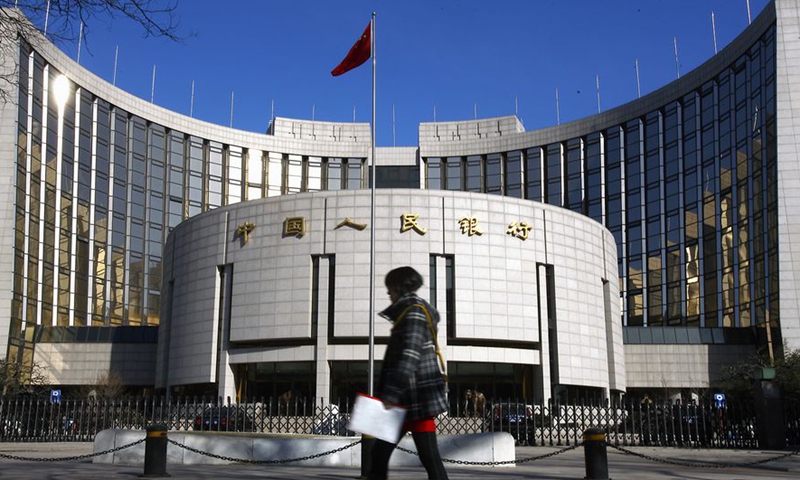
A file photo shows a pedestrian walks past the headquarters building of the People's Bank of China in Beijing, capital of China. (Xinhua)
China's central bank injected 10 billion yuan ($1.55 billion) on a net basis into the financial system on Monday, allaying woes over a cash crunch after its open market operations largely fell short of market expectations for ample liquidity provision ahead of the weeklong Spring Festival holidays.
With the economy on a firm footing, drastic policy easing measures such as reduced reserve requirement ratios (RRRs) are unlikely in the foreseeable future, market observers said, expecting no major moves ahead of the forthcoming holidays.
The People's Bank of China (PBC), the central bank, conducted 110 billion yuan worth of seven-day reverse repo operations at 2.2 percent on Monday, while 100 billion yuan of existing reverse repos expired.
Monday's net cash injection came on the heels of a rare move by the central bank to conduct a 14-day reverse repo auction of 50 billion yuan at 2.35 percent on Sunday, as the PBC sought to ensure stable liquidity ahead of the forthcoming holidays.
Although the central bank has continued money injections via reverse repo operations on weekdays since the start of the year, its reverse repo operations missed market expectations for most of January.
Its mini reverse repos, ranging between 2 billion yuan and 5 billion yuan, for 10 days in January, resulted in net withdrawals over the past month. In a sign of liquidity stress, the seven-day pledged repo rate for depository institutions in the interbank market hit a nearly five-year high of 3.1656 percent on February 1.
The resumption of large cash injections into the financial system since late January has helped ease liquidity squeeze concerns. The back-to-back open market operations calmed investor fears of monetary tightening.
The flagship Shanghai Composite Index closed up 1.03 percent on Monday, ending a three-day losing streak.
But there's no chance of any drastic monetary easing, analysts said, anticipating a continuation of monetary normalization.
"Temporarily, there are no conditions for a universal RRR cut, although targeted monetary policy support for small and micro-sized businesses and key manufacturers can't be ruled out," Liu Xuezhi, a senior research fellow at the Financial Research Center of Bank of Communications in Shanghai, told the Global Times on Monday.
Arguing against the possibility of a targeted RRR reduction before the Chinese Lunar New Year, Liu said the economy is making progress toward a recovery, making it unnecessary for ramped-up macro support.
Massive injections into the financial system since the economy was hit by the COVID-19 epidemic have run their course, he said, noting that the country has shifted toward a pro-cyclical monetary policy.
"While some in the market are looking for special and temporary liquidity arrangement such as CRA (Contingent Reserve Arrangement) and targeted RRR cuts, we think the probability of such arrangements is low, as they may send easing signals not aligned with the general policy direction," UBS economists led by Wang Tao wrote in a note sent to the Global Times.
While de facto tightening is being felt across the market, especially as curbs have recently been imposed on property fundraising to avert an excessively rapid rise in leverage, it's clear that policymakers would maintain a prudent monetary policy to stabilize economic growth and the equity market, Liu said.




